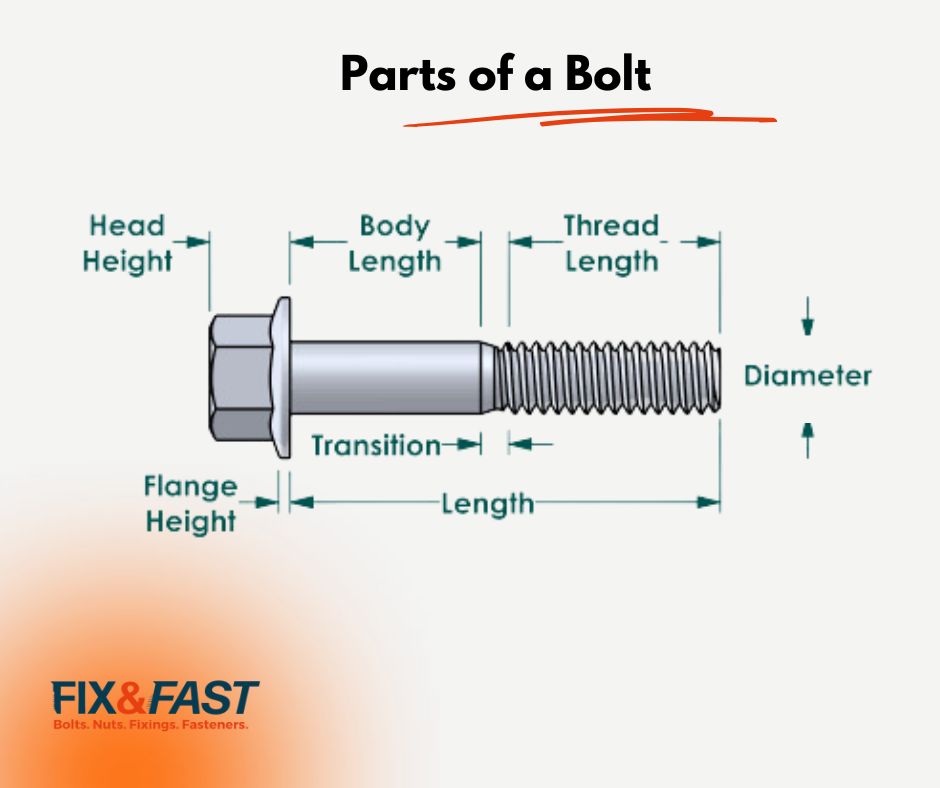How to Measure the Size of a Bolt Correctly
How to Measure the Size of a Bolt Correctly
How to measure the size of a bolt correctly?. It is a question we get asked regularly at Fix and Fast.
Understanding how to measure the size of a bolt is essential for DIY projects, repairs, and industrial applications. Bolts come in numerous sizes and specifications and selecting the right one can help or hinder a project. This guide will walk you through the key dimensions to measure and the tools required, ensuring you can accurately identify bolt sizes.

For the most accurate measurements of a bolt it's best to use measuring tools, and take 4 key measurements
Tools Needed
- Caliper: A precise measuring tool for diameter and length.
- Thread Gauge: A tool to measure the thread pitch.
- Ruler or Tape Measure: For general measurements.
- Bolt Gauge: A tool with pre-cut holes and threads for identifying bolt sizes.
Key Measurements
- Diameter
- Length
- Thread Pitch
- Head Size

Measuring the Bolt Diameter
The diameter of a bolt is the distance across the shank/thread . There are two types of diameters you need to be aware of: the major diameter (outer diameter) and the minor diameter (the diameter at the root of the threads).
Steps to Measure Diameter:
- Using a Caliper: Place the caliper’s jaws around the bolt's shank, ensuring they are perpendicular to the bolt. Read the measurement on the caliper. This will give you the major diameter.
- Using a Bolt Gauge: Insert the bolt into the gauge's holes until you find a snug fit. The corresponding hole size indicates the bolt’s diameter.

Measuring the Bolt Length
The length of a bolt is measured from the bottom of the head to the end of the bolt. However, if the bolt has a countersunk head, measure from the top of the head to the tip of the shank.
Steps to Measure Length:
- Using a Ruler or Tape Measure: Place the bolt alongside the ruler or tape measure, starting at the base of the head (or top for countersunk bolts). Read the measurement at the end of the shank.
- Using a Caliper: Place the bolt between the calliper’s jaws, ensuring the end of the shank aligns with one jaw. Read the measurement from the caliper.

Measuring the Thread Pitch of a Bolt
Thread pitch refers to the distance between threads on the bolt, measured in millimetres (metric bolts) or threads per inch (imperial bolts).
Steps to Measure Thread Pitch:
- Using a Thread Gauge: Select the thread gauge that fits into the bolt’s threads without gaps. The number on the gauge indicates the thread pitch (metric) or the number of threads per inch (imperial).
- Manual Method: For metric bolts, measure the distance between two threads and use a ruler to read the measurement in millimetres. For imperial bolts, count the number of threads in one inch.
Measuring the Head Size of a Bolt
The head size of a bolt is important for determining the correct socket or wrench to use.
Steps to Measure Head Size:
- Using a Calliper: Place the calliper’s jaws across the flat parts of the bolt head. Read the measurement on the calliper.
- Using a Bolt Gauge: Insert the bolt head into the gauge’s corresponding slot to find the size.
Additional Tips
- Identify the Bolt Grade: Bolts come in various grades, indicating their material and tensile strength. Look for markings on the bolt head. Higher grade bolts are used in applications requiring greater strength.
- Consult Standards: Familiarise yourself with standard bolt sizes and specifications, such as International Organization for Standardisation (ISO). These standards provide guidelines on bolt dimensions and tolerances.
- Consider Tolerances: Bolts have manufacturing tolerances. Ensure the measured size falls within the acceptable range specified by standards for your application.
- Speak with the experts: Our team at Fix and Fast are on hand over the phone and email to offer specific advice around sizing. We can also help you source specific niche fixings that may not be on our website.

Measuring a Bolt - A Round Up
Accurately measuring a bolt involves understanding its diameter, length, thread pitch, and head size.
Equipped with the right tools, such as a calliper, thread gauge, ruler, and bolt gauge, you can easily identify the correct bolt size for any project. Precision in measurement not only ensures the right fit but also contributes to the overall safety and efficiency of your work. Whether you’re a DIY enthusiast or a professional, mastering bolt measurement is a valuable skill in your toolkit
Remember our team of fixings experts are happy to help you. We have supplied fixings and fasteners since 1945 as FR Scott and more recently through our online ecommerce brand Fix and Fast.
Our expertise and passion for service has seen us rated excellent on Trustpilot For friendly fixings advice call 01482 324731 or email sales@fixandfast.co.uk.
Trade Accounts, with a range of benefits, are available - click to apply







